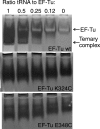Properties of Escherichia coli EF-Tu mutants designed for fluorescence resonance energy transfer from tRNA molecules
- PMID: 20083494
- PMCID: PMC2816605
- DOI: 10.1093/protein/gzp079
Properties of Escherichia coli EF-Tu mutants designed for fluorescence resonance energy transfer from tRNA molecules
Abstract
Here we describe the design, preparation and characterization of 10 EF-Tu mutants of potential utility for the study of Escherichia coli elongation factor Tu (EF-Tu) interaction with tRNA by a fluorescence resonance energy transfer assay. Each mutant contains a single cysteine residue at positions in EF-Tu that are proximal to tRNA sites within the aminoacyl-tRNA.EF-Tu.GTP ternary complex that have previously been labeled with fluorophores. These positions fall in the 323-326 and 344-348 regions of EF-Tu, and at the C terminus. The EF-Tus were isolated as N-terminal fusions to glutathione S-transferase (GST), which was cleaved to yield intact EF-Tus. The mutant EF-Tus were tested for binding to GDP, binding to tRNA in gel retardation and protection assays, and activity in poly-U translation in vitro. The results indicate that at least three EF-Tu mutants, K324C, G325C and E348C, are suitable for further studies. Remarkably, GST fusions that were not cleaved were also active in the various assays, despite the N-terminal fusion.
Figures



Similar articles
-
Design and properties of efficient tRNA:EF-Tu FRET system for studies of ribosomal translation.Protein Eng Des Sel. 2013 May;26(5):347-57. doi: 10.1093/protein/gzt006. Epub 2013 Feb 26. Protein Eng Des Sel. 2013. PMID: 23447652 Free PMC article.
-
GE2270A-resistant mutations in elongation factor Tu allow productive aminoacyl-tRNA binding to EF-Tu.GTP.GE2270A complexes.J Mol Biol. 2000 Dec 15;304(5):995-1005. doi: 10.1006/jmbi.2000.4260. J Mol Biol. 2000. PMID: 11124042
-
Probing the reactivity of the GTP- and GDP-bound conformations of elongation factor Tu in complex with the antibiotic GE2270 A.J Biol Chem. 1993 Nov 25;268(33):24622-8. J Biol Chem. 1993. PMID: 8227020
-
tRNA-ribosome interactions.Biochem Cell Biol. 1995 Nov-Dec;73(11-12):1049-54. doi: 10.1139/o95-112. Biochem Cell Biol. 1995. PMID: 8722020 Review.
-
Antibiotic resistance mechanisms of mutant EF-Tu species in Escherichia coli.Biochem Cell Biol. 1995 Nov-Dec;73(11-12):1167-77. doi: 10.1139/o95-126. Biochem Cell Biol. 1995. PMID: 8722034 Review.
Cited by
-
Labeled EF-Tus for rapid kinetic studies of pretranslocation complex formation.ACS Chem Biol. 2014 Oct 17;9(10):2421-31. doi: 10.1021/cb500409y. Epub 2014 Aug 22. ACS Chem Biol. 2014. PMID: 25126896 Free PMC article.
-
Design and properties of efficient tRNA:EF-Tu FRET system for studies of ribosomal translation.Protein Eng Des Sel. 2013 May;26(5):347-57. doi: 10.1093/protein/gzt006. Epub 2013 Feb 26. Protein Eng Des Sel. 2013. PMID: 23447652 Free PMC article.
-
A monovalent cation acts as structural and catalytic cofactor in translational GTPases.EMBO J. 2014 Nov 3;33(21):2547-63. doi: 10.15252/embj.201488517. Epub 2014 Sep 15. EMBO J. 2014. PMID: 25225612 Free PMC article.
-
Monitoring translation with modified mRNAs strategically labeled with isomorphic fluorescent guanosine mimetics.ACS Chem Biol. 2013 Sep 20;8(9):2017-23. doi: 10.1021/cb400256h. Epub 2013 Jul 18. ACS Chem Biol. 2013. PMID: 23865809 Free PMC article.
-
Identification of an antibiotic from an HTS targeting EF-Tu:tRNA interaction: a prospective topical treatment for MRSA skin infections.Appl Environ Microbiol. 2025 Jan 31;91(1):e0204624. doi: 10.1128/aem.02046-24. Epub 2024 Dec 23. Appl Environ Microbiol. 2025. PMID: 39714192 Free PMC article.
References
-
- Anborgh P.H., Parmeggiani A., Jonak J. Eur. J. Biochem. FEBS. 1992;208:251–257. - PubMed
-
- Andersen C., Wiborg O. Eur. J. Biochem. FEBS. 1994;220:739–744. - PubMed
-
- Blechschmidt B., Shirokov V., Sprinzl M. Eur. J. Biochem. FEBS. 1994;219:65–71. - PubMed
-
- Boon K., Vijgenboom E., Madsen L.V., Talens A., Kraal B., Bosch L. Eur. J. Biochem. FEBS. 1992;210:177–183. - PubMed
Publication types
MeSH terms
Substances
Grants and funding
LinkOut - more resources
Full Text Sources
Other Literature Sources
Research Materials

